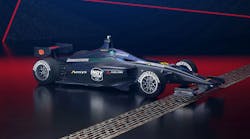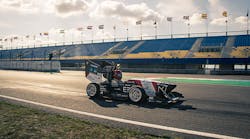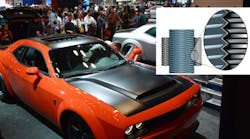Recent
When he slams his foot down on the accelerator and his car thunders from 0 to 60 in 4.4 seconds, Sergey Karyakin has no time for any doubts. His team, SNAG Racing, competes in cross-country races across the deserts of Morocco, Chile, Peru, throughout the mountains of Bolivia, and over the vast steppes of Russia and Mongolia. Their custom-designed cars experience brutal conditions at all altitudes and temperature ranges.
Their most recent race was the Rallye du Maroc in October 2019, a 5-day race demanding they cover 1,557 miles (2,506 kilometers) and cross the finish line in one piece. Easier said than done. The Rallye took them through rock-strewn deserts, over sand dunes as far as the eye could see, unforgiving salt flats, skirting along mountainsides with blind corners only steps ahead. After all the results were in, SNAG Racing took home the Silver Medal in their category. And that’s not their first victory. Far from it.
SNAG Racing doesn’t race with commercial race cars. Rather, they start with a 172-hp Can-Am Maverick X3 RS Turbo R and build a new chassis to comply with the race entry requirements of the FIA (Fédération Internationale de l'Automobile), but they don’t stop there. As a professional racing team with serious corporate sponsors, they can’t rest for long. And they don’t.
Early on in his career, Sergey understood that the difference between either winning or losing a race is far more than just luck. A huge part of the equation is the car itself, because, in his words, “When the drivers are all top-level, even small boosts in performance can give you those golden few extra seconds needed to launch you over the finish line first.”
To crank up their performance to the next level, they began designing new components for their cars, to reduce weight, increase strength, maneuverability, etc. What the initial steps of the design process originally consisted of was using paper modeling to construct a mock-up, after which they would transition to sheet metal, then welding, and then the multi-step process of fabrication would commence. It wasn’t unusual for it to take two months or more for just one simple part to be readied for installation. But with a packed schedule that often gives them just weeks before another race in another country, this old way of making parts was unacceptable.
That’s when Sergey discovered 3D scanning and additive manufacturing. He was introduced to the professional handheld 3D scanner Artec Eva by Artec Reseller Cybercom Ltd. Eva is a lightweight 3D scanner used around the world in fields such as reverse engineering, manufacturing, healthcare, and others. Cybercom are specialists in 3D scanning and printing, as well as service providers, and offer a wide range of solutions to match any relevant application.
Cybercom showed Sergey and his team how the combination of Artec Eva and Artec Studio scanning and post-processing software could slash their production times and costs while making it possible for them to create their own parts of higher specs.
In the days and weeks that followed, Sergey and his team put in place the 3D scanning and design process which they still use today. According to Sergey, their workflow goes like this: “First we prepare a part to scan, and that can be anything from a-arms, mounting points, shocks, links, knuckles, other suspensions, and frame parts, etc. We clean it up to get the surface ready for best results, making sure it’s fixed in place, and then we push the scan button and do the scan, just moving the scanner around the object and watching on the laptop screen as the 3D scan is coming to life. To be frank with you, it’s as easy as pie!”
By first digitally capturing the original parts’ geometries and mounting points in precise submillimeter 3D, Artec Eva has allowed SNAG Racing to reverse engineer a whole range of parts to make them lighter, stronger, and more durable, which translates into faster, tougher cars to match the punishing conditions that they face countless times in every race. Sometimes their designs are so dramatic, only the mounting points remain the same, while other times, the modifications are subtler and mostly focused on switching to new, higher-performance materials.
Everyone on the team has noticed the striking contrasts in their production capacity and shorter turnaround times. “Essentially one of us can scan half-a-dozen parts before lunchtime, including post-processing in Artec Studio, and then have the 3D models exported over to CAD by that afternoon,” said Sergey.
Today it takes them a max of three weeks from start to finish to custom design and produces new parts, and that includes everything from the initial 3D scanning to CAD design, CNC milling or 3D printing in various plastics, metals, carbon, Kevlar, etc. One of the best things that 3D scanning and additive manufacturing have done for SNAG Racing is that it’s opened up an entire avenue of new possibilities.
“I can say that this is the future of small-team racing right here. It doesn’t require any advanced training. I’m a race car driver, not a design engineer, but I can do this. And my technicians are now doing this. With Artec, we can design and implement new ideas in such a short span of time, without having to depend on any parts suppliers, who definitely won’t have the flexibility and know-how to make the kinds of parts we’re making now, exactly how we need, when we need them,” said Sergey.
He continued, “Artec is allowing us to push our creative boundaries further than I ever imagined. Sure, it’s a rally car built on a commercially available foundation, but from there, 3D scanning has opened the door for us so we can make our cars exactly as we’ve dreamed, within short timeframes, and within budget.”
“When I was first checking out 3D scanning and 3D printing, there were traditional guys who said it was dangerous to try and do this work ourselves. But I didn’t listen to them. Listening to them would mean standing in line behind all the other guys. And I want to be first. For me, that’s what 3D scanning is all about: bringing the power to innovate right here into our hands, where we can create what we know will work best, not wait around and hope that somebody will make for us what we need right now.”
Any doubts about the durability and longevity of their in-house parts have long since vanished. There were serious concerns in that direction, especially in the beginning. But time and experience have proven them right.
As Sergey explained, “Our version of quality inspection is like this: because we’re all experts at racing, after each leg of a race, we get right in there and check out the custom parts up close, so we know what kinds of wear and tear they’re going through if any. New designs get that much more inspection, so nothing slips past us. We’re experimenting with new materials and designs all the time, and we keep detailed notes about everything, which is the only way to do it as far as I’m concerned.”
Sergey said they’re not stopping there, because with the winning results they’ve achieved with all their designs in races on both sides of the world, they want to kick things up to the next gear in terms of their high-performance modifications, “We’re now devoting more focus to fusing various composite materials with metals, to get the best from both worlds, essentially marrying flexibility and ultra-lightweight with maximum strength. So far the results have been extremely encouraging.”












